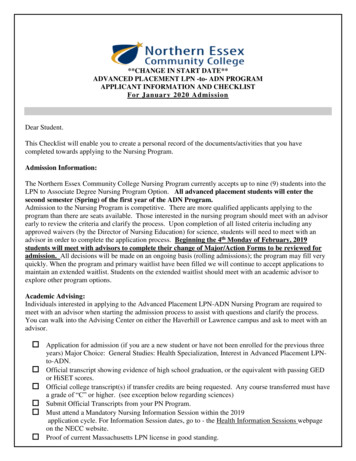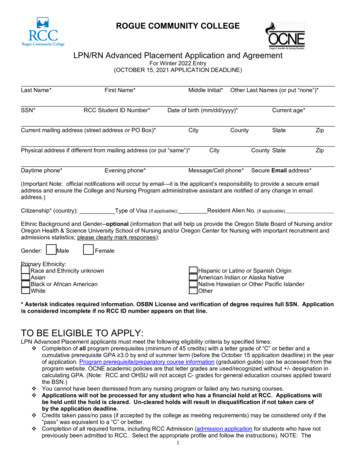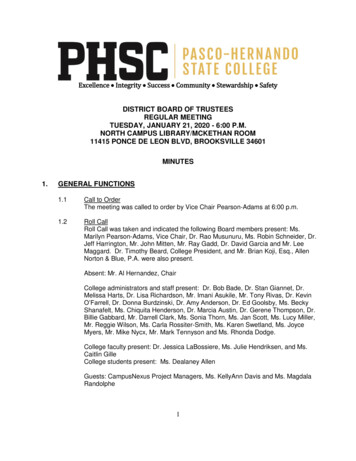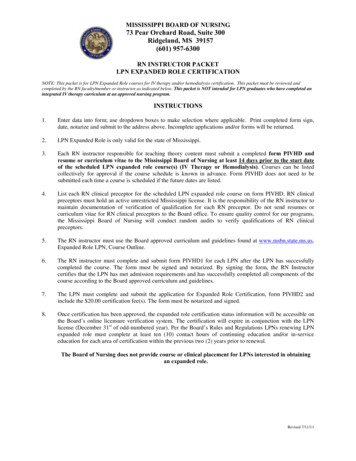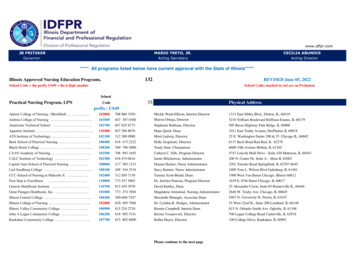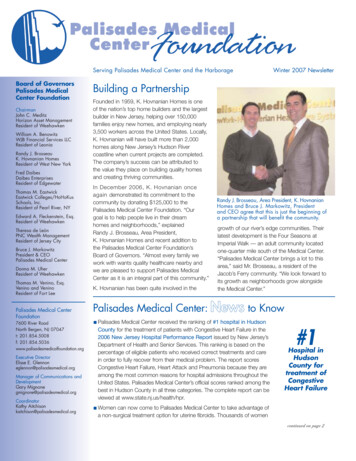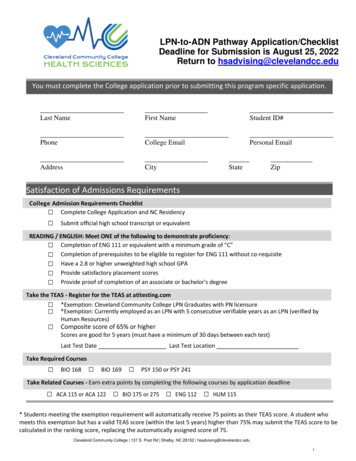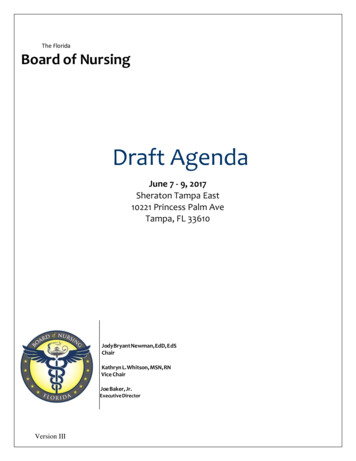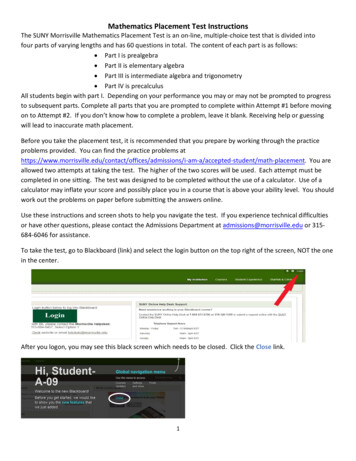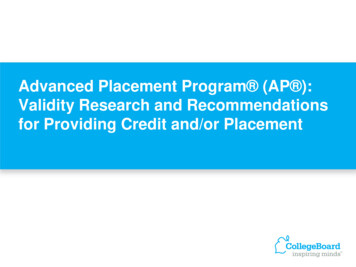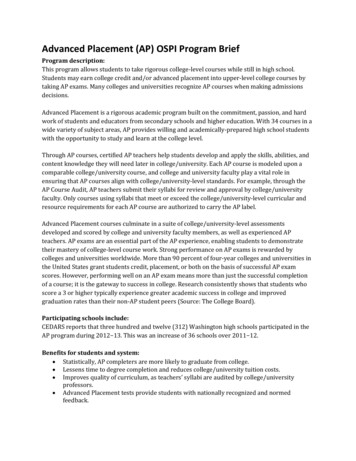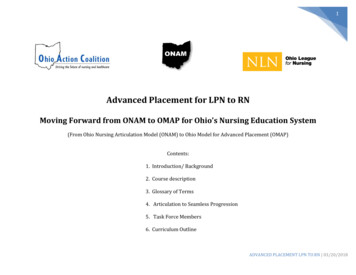
Transcription
1Advanced Placement for LPN to RNMoving Forward from ONAM to OMAP for Ohio’s Nursing Education System(From Ohio Nursing Articulation Model (ONAM) to Ohio Model for Advanced Placement (OMAP)Contents:1. Introduction/ Background2. Course description3. Glossary of Terms4. Articulation to Seamless Progression5. Task Force Members6. Curriculum OutlineADVANCED PLACEMENT LPN TO RN 03/20/2018
2Advanced Placement for LPN to RNMoving Forward from ONAM to OMAP for Ohio’s Nursing Education System(From Ohio Nursing Articulation Model (ONAM) to Ohio Model for Advanced Placement (OMAP)Purpose:The Ohio Model for Advanced Placement LPN to RN (OMAP) was developed to update a coordinated system of nursing education in Ohioto facilitate a seamless academic progression model for LPN to RN students. This document provides a historical perspective of the LPN toRN model in Ohio, provides a description of the intent of the LPN to RN course, defines key terms related to advanced placement, andprovides a suggested curriculum outline for an LPN to RN transition course in the state of Ohio.Background:In 2003, the Ohio Nursing Articulation Model (ONAM) was developed by the Ohio Nursing Collaborative for Educational Mobility(ONCEM) patterned after the Access in Nursing model developed by the Nursing Education Mobility Action Group (NEMAG) in northeastOhio. Representatives from all nursing education programs in Ohio as well as nursing practice sites provided input into the developmentof ONAM. The goal was to provide quality nursing education to RN to BSN and LPN to RN nurses without unnecessary duplication whileprotecting and promoting the health of the citizens of sing.org/resource/resmgr/RWJ Grant Files/HFFinalDocument.pdfThe Ohio Model for Advanced Placement LPN to RN (OMAP) was developed as the next phase in the evolution to create a coordinatedsystem of nursing education in Ohio that enables and focuses on optimal educational mobility for LPN to RN nurses. The Ohio Model forAdvanced Placement LPN to RN was developed through a collaborative of representatives from practical nursing, diploma nursing,associate degree nursing and baccalaureate degree nursing programs from all regions of Ohio. Based on the original assumptions andprinciples of ONAM, the task force revised the transition course to better reflect current trends and practices in nursing education. Thecourse serves to validate prior learning, enhance the student’s knowledge, skills, and attitudes, begin the process of role transition andprepare the student for advanced placement into the RN program.ADVANCED PLACEMENT LPN TO RN 03/20/2018
3Course Description: The course is designed to enable the student to explore integrative concepts in nursing and assist the student in transition fromlicensed practical nurse to registered nurse.Students will refine and enhance previous learning in addition to identifying goals for successful transition into the registerednursing program.Through a variety of learning experiences, the student learns through application of concepts.The student will demonstrate the ability to solve problems through the using the nursing process with a focus on clientassessment and communication.Glossary of Terms:1. Seamless academic progression – Partnership between two nursing education programs whereby curriculum is designedcollaboratively between the academic institutions and enabling students to transition automatically and seamlessly from one level ofnursing education to the next.2. Articulation - The process through which nursing programs cooperate to facilitate educational progress of students with minimalrepetition of coursework.Evolution from Articulation to Seamless Progression:Historically, the term “academic progression” referred to articulation models that promoted the addition of academic credentials innursing. These articulation agreements supported educational mobility and facilitated the seamless transfer of academic creditbetween the different levels of nursing education programs. However, these models were institutionally specific with nocoordination of admission processes or curricular requirements.The Institute of Medicine (IOM) report, The Future of Nursing: Leading Change, Advancing Health released in 2011 called for thetransformation of nursing education to meet America’s increasing healthcare needs. The report’s recommendation is to increasethe proportion of nurses with baccalaureate degrees to 80% by 2020. To meet this goal, the Campaign for Action through theRobert Wood Johnson Foundation, American Association of Retired Persons (AARP) and the AARP Foundation provided fundingADVANCED PLACEMENT LPN TO RN 03/20/2018
4to states to develop seamless progression models for nursing that go beyond articulation agreements between academicinstitutions.Seamless academic progression models in nursing are collaborative partnerships between two nursing education programs thatenable students to transition automatically from one level of nursing education to the next. A curriculum is designedcollaboratively to ensure that the required prerequisites and nursing coursework align. Students may be simultaneous ly enrolledin both partnering nursing programs through dual or concurrent admission options. Higher-level nursing courses are often takenconcurrently or interspersed with lower level courses such as BSN courses while completing ADN program requirements.The transformation of nursing practice for the future requires a fundamental re-design of nursing education. We must create newpartnerships between nursing education and practice to provide opportunities for a seamless transition to higher degree programs andlifelong learning. The design and implementation of seamless models that promote academic progression is vital to meet this national callfor a highly educated and competent nursing workforce.Task Force Members:Connie Bowler, DNP, RN, ChairLakeland Community CollegeJane Mahowald, MA, RN, ANEFOhio League for Nursing/Ohio Action CoalitionWendy Batch-Wilson, DNP, RNCuyahoga Community CollegeStephanie Miller, MSN, RNATECHPamela Bonnett, DNP, RN, CNEUniversity of AkronDonna Mitchell, PhD, RNUniversity of Rio GrandeAnnie Carpenter, MSN, RN, CNECentral Ohio Technical CollegeTracey Motter, DNP, RNKent State UniversityKaren Ciminero, MSN, RNEastern Gateway Community CollegeHolly J. Price, MSN, RN, CNS, CNE, ANEFFirelands Regional Medical Center, School ofNursingChristine Dimaculangan, MSN, RN, CNEGalen CollegePatricia Schrull, DNP, MBA, M.Ed, RN, CNELorain County Community CollegeADVANCED PLACEMENT LPN TO RN 03/20/2018
5Carol Drennen, MSN, MS, RNOhio Action CoalitionNancy Wagner, PhD, RN, CNEYoungstown State UniversityReferences:1. Institute of Medicine. (2011). The Future of Nursing: Leading Change, Advancing Health. Washington, DC: Author.2. National League for Nursing (2011). Academic Progression in Nursing Education. Retrieved from: ries-%28position-statements%29/nlnvision 1.pdf?sfvrsn 43. Ohio Nursing Collaborative for Educational Mobility (2005). The Ohio Nursing Articulation Model. Retrieved sing.org/resource/resmgr/RWJ Grant Files/HFFinalDocument.pdfADVANCED PLACEMENT LPN TO RN 03/20/2018
6Model for Advanced Placement: Suggested CurriculumConceptCourse OutcomesAt the end of the course,the learner will be able to:Unit ObjectivesAt the end of the unit the learner will beable to:Suggested ContentDiscuss self-perception of the current LPNrole.Professional Role andResponsibilities Evolution of nursing Professionalization ofnursing Scope of practice Education pathways Educational mobility Emerging expanded rolesUnit I Concepts Basic toTransitionProfessionalRoleDefine specific role changesnecessary for the transitionfrom LPN to RNIdentify individual strengths and areasneeding improvement.Compare and contrast LPN practice with RNpractice in relation to: scope of practice,nursing functions and skills, and leadershipresponsibilities.Role TransitionDefine specific role changesnecessary for the transitionfrom LPN to RNCompare characteristics of the provider rolewith the student role.Explain changes in peer relationships thatmay occur with role changes.Role Transition Motivational forces forreturning to school The concept of role:Social rolesRoles and identityRole changesADVANCED PLACEMENT LPN TO RN 03/20/2018
7Role StrainDefine specific role changesnecessary for the transitionfrom LPN to RNDescribe the problems and conflictsresulting from the multiple roles LPNstudents hold.Define role overload.Describe effective strategies that enhancecoping with multiple role conflictsActions that aide in achieving goals.LearningHealthy CopingEstablish personal goals forsuccess in selected RNprograms incorporating theconcepts of self-directedlearning, time management,and values clarification.Describe characteristics of adult learners.Establish personal goals forsuccess in selected RNprograms incorporatingconcepts of self-directedlearning, time management,and values clarification.Identify major causes of stress fortransitioning students.Describe how concepts of adultlearning/self-directed learning are appliedto the student role.Describe effect of stress on one's health.Role strain/stressors Changes in peerrelationships Role ambiguity Role overload Returning to SchoolSyndrome:Honeymoon stageConflict stageResolution stageSelf-Directed Learning Assumptions aboutlearning Theories of learning Andragogy versuspedagogy Comparison of assumptionsand processesStress management Definition of stress Difference between stressand anxiety Sources of stress Personal/ObviousADVANCED PLACEMENT LPN TO RN 03/20/2018
8Describe coping skills for dealing with stresssituation. ProfessionalSymptoms of stress overloadReview principles of test taking that reducetest-anxiety.TimeManagementEstablish personal goals forsuccess in selected RNprograms incorporating theconcepts of self-directedlearning, time management,and values clarification.Explain the relationship between effectivetime management and educational success.Describe effective strategies to improvetime management.Time Management Concept of time Perspectives on timemanagement Common myths on timemanagement Common myths of timemanagement Segmentation ConcentrationUnit II : TherapeuticCommunicationCommunicationUse therapeuticcommunication techniques toestablish a baseline fornursing decisions.Describe essential aspects of communicationand the communication process.Professional Communication: Modes of communication Communication process Communication skills forhelping relationships Communication skills forRN’s Delegation Conflict resolution Team buildingADVANCED PLACEMENT LPN TO RN 03/20/2018
9Describe factors influencing thecommunication processIdentify therapeutic and non-therapeutictechniques used by nurses whencommunicating with clients.Identify communication problems andstrategies to resolve communication issues.Communication Process Factors influencingtherapeutic communication Essential aspects oftherapeutic communication Partners and other healthcare professionals intherapeutic communication Patient input into all aspectsof the nursing process.Communication Techniques Therapeutic techniques Non-therapeutic techniques Communication goals andoutcomesCommunication Problems andStrategies Barriers to therapeuticcommunication Strategies to overcomebarriers to therapeuticcommunication, conflictresolution Developing skills for ahelping relationshipsADVANCED PLACEMENT LPN TO RN 03/20/2018
10Utilizing electronic communication with allmembers of the health care team.Electronic Communications HIPAA Forms of electroniccommunication Describe safe electroniccommunication withpatients in a health caresetting Utilize electroniccommunication tostreamline and enhancepatient careUnit III Nursing ProcessNursing ProcessDevelop patient-centeredplans of care using thenursing process whichpromote health, safety, interprofessional communication,and evidence-based practice.Describe how the nursing process is aOverview of the nursing process:framework for accountability, responsibility, Assessmentproblem solving, and individualized care. Purpose Sources of data Identifying patterns Communicating anddocumenting data. Assessment typeshead to toefocusedquick priority Organization of dataADVANCED PLACEMENT LPN TO RN 03/20/2018
11Analyze data to identify nursing problemsand priority medical issues.Describe the aspects of planning nursingstrategies/interventions.Identify essential components ofimplementing nursingstrategies/interventions.Diagnosis/Analysis Interpretation of data Validation of data Establishingproblem/diagnoses Prioritization ofproblems/diagnosesFirst orderSecond orderThird orderFourth order Diagnostic reasoningPlanning Documentation of the planof care Institutionalized Standardized systems ofdocumentation Errors in the planningprocess Prioritization of patients Principles of workorganization Organizational toolsImplementation Setting daily priorities Communication of priorities Delegation Nursing surveillanceADVANCED PLACEMENT LPN TO RN 03/20/2018
12Describe the components of evaluation. Ongoing assessmentEvaluation Outcome criteria Evaluating planeffectiveness Modifying the plan of care Termination of the plan ofcareUnit IV Legal EthicalEthicsDescribe the ethico-legalconcepts that can be appliedto promote clinical judgment,patient safety and qualitynursing care in the healthcare setting.Discuss the relationship of statutory andcommon law to nursing.Describe the elements of negligence andmalpractice including common violations.Define ethical principles.Sources of the law Statutory Law Ohio Nurse Practice Act ORCCommon law Standards of Care Negligence/ Malpractice Elements required Common violationsHIPAA violationsFailure to rescueInformed consentPatient rightsAssault and battery Prevention of law suitsEthical Principles Autonomy Veracity Fidelity BeneficenceADVANCED PLACEMENT LPN TO RN 03/20/2018
13Discuss the ANA Code of Ethics as a basis fordecision-making when nurses are faced withethical dilemmas. Non-maleficence JusticeEthical Dilemmas ANA Code of Ethics Ethics CommitteesUnit V: Teaching andlearningPatienteducationDevelop an individualizedpatient education plan basedon the learning needs of thepatient and/or significantothers.Describe three theories of learning.Basic principles of Learning andteaching Facilitating learning Theories of LearningBehaviorismCognitivismHumanism Andragogy versus Pedagogy Domains oflearning/Bloom’s Taxonomy Types of changeList factors that facilitate learning.Principles of Learning Factors facilitatingMotivationReadinessFeedbackRepetition Factors inhibitingElevated anxiety levelADVANCED PLACEMENT LPN TO RN 03/20/2018
14Explain three domains of learning. Explain essential factors in assessing forlearning.Verbalize the need for patient education.Physiologic eventsCultural barriersProcess of teaching patientsand familiesDomains of learningCognitiveAffectivePsychomotorComparison of teaching process andnursing process Assessing Identifying learning needs Identifying current level ofknowledge Identifying learner’s level ofunderstanding Identifying client readiness Identifying motivation Identifying learning styleDiagnosing Impact of education onpatient outcomes Types of knowledge deficits Examples of nursingdiagnosisADVANCED PLACEMENT LPN TO RN 03/20/2018
15Describe the essential aspects of a teachingplan.Developing a teaching plan Determining teachingpriorities Setting learning objectives Selecting teaching strategiesExplanationOne to one discussionAnswering questionsDemonstrationReturn demonstrationGroup discussionPracticePrinted/audio visualmaterialsRole playingModelingDetermining contentFacilitating and orderinglearning experiencesIdentify barriers to patient learning.Implementing planning Barriers to learning Physical Psychosocial Biorhythms PrognosisTeaching StrategiesADVANCED PLACEMENT LPN TO RN 03/20/2018
16 Nursing ProcessAssessmentUnit VI: Health AssessmentTechniques for Physical AssessmentDevelop patient-centeredplans of care using thenursing process whichpromote health, safety, interprofessional communication,and evidence-based practice.Compare and contrast comprehensiveepisodic or focused centered assessmentsand follow up assessments.Utilize communication techniques thatenhance data collection.Client contractingGroup TeachingBehavior modificationsEvaluation ofteaching/learningeffectivenessLegal implicationsDemonstration of learningDischarge follow-up oflearningDocumentation of learningPurpose of the Health History Health AssessmentComprehensiveEpisodic or ion with Clients Types of Questions Techniques that LimitCommunicationCultural Considerations Cultural SensitivityADVANCED PLACEMENT LPN TO RN 03/20/2018
17Develop methods to assess culturalinfluences on health care.Define the components and content of anursing health history.Describe equipment required for healthassessment. Effective cultural practices ResourcesTypes of Data Collected Biographic Reason for Seeking Care Present Health Status Past HealthHistory/Reviewing MedicalRecords Family History Review of Systems Cultural and Social Influences Functional Assessment Personal Health PerceptionEquipment Thermometers Stethoscope Sphygmomanometer Doppler Pulse Oximeter Vision Acuity Ophthalmoscope Otoscope Reflex Hammer Tuning Forks Audiometer CalibersADVANCED PLACEMENT LPN TO RN 03/20/2018
18 ScaleDefine, describe, and demonstrateinspection, auscultation, palpation, andpercussion.Describe positioning for effectiveassessment.Describe the purpose, equipment andtechniques used for the measurement ofvital signs including height and weight.Describe factors that affect measurement ofvital signs.Assessment Techniques Inspection Auscultation Palpation PercussionPositioning General Survey Gathering AccurateInformation Patient safetyVital Signs Temperature Pulse Respiration Blood Pressure General Assessment Weight Height Skinfold Thickness Body Mass Index(BMI)Factors Affecting Measurement Positioning Fluid volume OthersADVANCED PLACEMENT LPN TO RN 03/20/2018
19Assessment of IntegumentaryDescribe the anatomy of the integumentarysystem.Describe expected findings described fromthe physical examination of hair, skin &nails.Delineate age related and ethnic variationsof anatomy and physiology that can benoted in assessment of the hair, skin andnails.Discuss health promotion practices that arepertinent to the integumentary system.Anatomy Review Health History (SubjectiveData Collection) Physical Examination(Objective Data Collection) Skin Hair NailsVariations Age Cultural Situational Common IntegumentaryProblemsHealth Promotion Mole examination Sun Screen OtherADVANCED PLACEMENT LPN TO RN 03/20/2018
20Assessment of the Head, Neck, &Lymphatic System, Eyes and EarsDescribe the anatomy of the head, neck andlymphatic system.Anatomy Review Health History (Subjective DataCollection) Physical Examination (ObjectiveData Collection)HeadNeckThyroidLymph Nodes Delineate age related, cultural andsituational variations of the anatomy andphysiology that can be noted in assessmentof the head, neck and lymphatic systems.Demonstrate appropriate inspection,palpation and positioning techniques usedin the examination of the head, neck andlymphatic systems.Describe expected normal findings andabnormal variations with disorders derivedfrom the physical examination anddiagnostic evaluation of the head, neck andlymphatic systems.Variations Age Cultural SituationalConsider lab, simulation, or clinicalexperience Findings Associated withDisordersADVANCED PLACEMENT LPN TO RN 03/20/2018
21Discuss health promotion practices for thehead, neck and lymphatic systems.Describe the anatomy and physiology of thevisual and auditory system.Delineate age related, cultural andsituational variations of the anatomy andphysiology that can be noted in assessmentof the eyes and ears.Demonstrate appropriate use of equipmentfor the examination of the visual andauditory systems. Health Promotion DocumentationAnatomy Review Health History (Subjective DataCollection) Physical Examination(ObjectiveData Collection) Diagnostic Findings (ObjectiveData)Variations Age Cultural SituationalConsider lab, simulation, or clinicalexperience.Demonstrate appropriate inspection,palpation, and positioning techniques usedin the examination of the eyes and ears.Describe expected normal findings andabnormal variations from the physicalexamination and diagnostic evaluation ofthe visual and auditory systems. Findings Associated withDisorders Health PromotionADVANCED PLACEMENT LPN TO RN 03/20/2018
22Discuss health promotion practicespertinent to the sensory system.Nursing Assessment of the RespiratorySystemDescribe the anatomy and physiology of therespiratory system.Describe the expected normal and abnormalfindings described from physicalexamination and diagnostic studies of therespiratory system.Delineate age related, cultural, andsituational variations of anatomy andphysiology that can be noted in assessmentof the respiratory system.Demonstrate appropriate inspection,palpation, percussion, auscultation andpositioning techniques used in theexamination of the respiratory system. DocumentationAnatomy and Physiology Review Health History (Subjective Data) Physical Examination (ObjectiveData) Nose Sinuses Mouth Throat Chest Wall Inspection Palpation Percussion AuscultationVariations Age Cultural SituationalConsider lab, simulation, or clinicalexperience. Common Respiratory ProblemsADVANCED PLACEMENT LPN TO RN 03/20/2018
23Discuss health promotion practices that arepertinent to the respiratory system.Assessment of Cardiovascular andPeripheral Vascular SystemDescribe the anatomy and physiology of theheart and peripheral vascular system.Describe the expected normal findings andabnormal findings described from physicalexamination and diagnostic studies of theheart and peripheral vascular system.Delineate age related, cultural andsituational variations of anatomy andphysiology that can be noted in assessmentof the heart and vascular system.Demonstrate appropriate inspection,palpation, auscultation and positioning Health Promotion DocumentationAnatomy & Physiology Review Health History (Subjective Data) Physical Examination (ObjectiveData) Blood PressurePulseSkin, Hair, NailsVenous AssessmentNeck VesselsPrecordium AssessmentLower ExtremitiesDiagnostic StudiesVariations Age Cultural SituationalConsider lab, simulation, or clinicalexperienceADVANCED PLACEMENT LPN TO RN 03/20/2018
24techniques used in the examination of theheart and vascular system.Discuss health promotion practices that arepertinent to the heart and peripheralvascular system.Nursing Assessment of the AbdomenDescribe the anatomy of the abdomen.Describe the expected findings normal andabnormal findings from physicalexamination of the abdomen.Delineate age related, cultural, andsituational variations of anatomy andphysiology that can be noted in assessmentof the abdomen.Demonstrate appropriate inspection,palpation, percussion, auscultation andpositioning techniques used in theexamination of the abdomen. CommonProblems/Conditions Health Promotion DocumentationGraphingNarrative DescriptionAnatomy Review Health History (SubjectiveData) Physical Examination(Objective Data) Inspection Auscultation Palpation PercussionVariations Age Cultural SituationalConsider lab, simulation, or clinicalexperience.ADVANCED PLACEMENT LPN TO RN 03/20/2018
25Discuss health promotion practices that arepertinent to the abdomen.Assessment of Muscular SystemDescribe the anatomy of themusculoskeletal system. Common Problems Health Promotion DocumentationAnatomy Review Health History (SubjectiveData) Physical Examination(Objective Data)Describe the expected normal findings andabnormal variations from physicalexamination of the musculoskeletal system.Findings Normal findings Abnormal findings Inspection & ROM techniques PalpationDelineate age related, cultural andsituational variations of anatomy andphysiology that can be noted in assessmentof the musculoskeletal system.Variations Age Cultural SituationalDemonstrate appropriate inspection,palpation, and positioning techniques usedin the examination of the musculoskeletalsystem.Consider lab, simulation, or clinicalexperience.ADVANCED PLACEMENT LPN TO RN 03/20/2018
26Discuss health promotion practices that arepertinent to the musculoskeletal system. Common Problems Health Promotion DocumentationAssessment of Neurological SystemDescribe the anatomy and physiology of theneurological system.Describe the expected normal findings andabnormal deviations from physicalexamination of the neurological system.Delineate age related and situationalvariations of anatomy and physiology thatAnatomy & Physiology Review Health History (SubjectiveData) PhysicalExamination(Objective Data)Findings Cranial Nerves Coordination and Fine MotorSkills Proprioception Sensory Function Pain Sharp Dull ReflexesVariations Age CulturalADVANCED PLACEMENT LPN TO RN 03/20/2018
27can be noted in assessment of theneurological system.Demonstrate appropriate inspection,palpation, percussion, and positioningtechniques used in the examination of theneurological system.Discuss health promotion practices that arepertinent to the neurological and mentalhealth system.Fluid balanceUnit VII : Fluid TherapyIV TherapyDiscuss the role of theregistered nurse in IVtherapy.Identify the responsibilities of the registerednurse in parenteral therapy. SituationalConsider lab, simulation, or clinicalexperience. Common Problems andConditions Health Promotion DocumentationRN Parenteral TherapyResponsibilities Policies/procedures Equipment Calculations Documentation Safety/Infection control Recognizing and addressinginfusion relatedcomplications Procedures requiring RN Administration of IV pushmedication Responsibilities SafetyADVANCED PLACEMENT LPN TO RN 03/20/2018
28 Central Venous TherapyIndicationsTypesNursing responsibilitiesand interventionsParenteral od AdministrationIndicationsBlood groups andincompatibilitiesBlood productsSafetyTransfusion reactionsADVANCED PLACEMENT LPN TO RN 03/20/2018
nursing program. Through a variety . Cuyahoga Community College ATECH Pamela Bonnett, DNP, RN, CNE Donna Mitchell, PhD, RN University of Akron University of Rio Grande Annie Carpenter, MSN, RN, CNE Tracey Motter, DNP, RN Central Ohio Technical College Kent State University Karen Ciminero, MSN, RN Holly J. Price, MSN, RN, CNS, CNE, ANEF .
